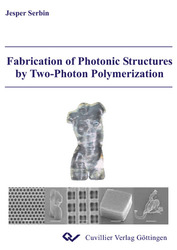| Fachbereiche | |
|---|---|
| Buchreihen (96) |
1378
|
| Nachhaltigkeit |
3
|
| Gesundheitswesen |
1
|
| Geisteswissenschaften |
2362
|
| Naturwissenschaften |
5406
|
| Mathematik | 229 |
| Informatik | 319 |
| Physik | 980 |
| Chemie | 1363 |
| Geowissenschaften | 131 |
| Humanmedizin | 243 |
| Zahn-, Mund- und Kieferheilkunde | 10 |
| Veterinärmedizin | 108 |
| Pharmazie | 147 |
| Biologie | 835 |
| Biochemie, Molekularbiologie, Gentechnologie | 121 |
| Biophysik | 25 |
| Ernährungs- und Haushaltswissenschaften | 45 |
| Land- und Agrarwissenschaften | 1004 |
| Forstwissenschaften | 201 |
| Gartenbauwissenschaft | 20 |
| Umweltforschung, Ökologie und Landespflege | 148 |
| Ingenieurwissenschaften |
1790
|
| Allgemein |
97
|
|
Leitlinien Unfallchirurgie
5. Auflage bestellen |
|
Erweiterte Suche
Fabrication of Photonic Structures by Two-Photon Polymerization
Jesper Juul Serbin (Autor)Vorschau
Inhaltsverzeichnis, Datei (35 KB)
Leseprobe, Datei (84 KB)
Since the publications of E. Yablonovitch and S. John in 1987 on the optical properties of three-dimensional periodic structures the interest on photonic crystals has increased rapidly mainly driven by progress in their theoretical description. On the experimental side, the fabrication of photonic crystals still remains a major challenge since the fabrication methods either lack quality, flexibility or resolution. Subject of this thesis is the development of a new technique for the generation of threedimensional structures on the sub-micrometer scale that is suitable for the fabrication of photonic crystals. The crystals fabricated using this technique are characterized and their optical properties are discussed. If near-infrared femtosecond laser pulses are tightly focused into the volume of a transparent, photosensitive resin, two-photon absorption within the focal volume leads to photopolymerization. By moving the laser focus three-dimensionally through the volume of the resin, any 3D structure can be fabricated by means of two-photon polymerization. After the polymerization process the non irradiated polymer can be etched away with special solvents leaving the solid 3D structure that was exposed by the focused femtosecond pulses. Due to the threshold behavior of the two-photon polymerization process, one can overcome the diffraction limit by choosing the applied peak laser fluence just slightly above the threshold for polymerization. In this case only the central part of the laser focus contributes to the polymerization process. It is shown that complicated 3D structures with a resolution as small as 100 nm can be fabricated by means of two-photon polymerization using a laser wavelength of l=780 nm. Woodpile structures having a face-centered-cubic symmetry and a photonic bandgap in the near infrared were fabricated with two-photon polymerization and were optically characterized by means of Fourier-transform infrared spectroscopy. Since the refractive index contrast in polymeric crystals is not high enough to provide a complete photonic bandgap, the fabricated woodpile structures were used as templates for the infiltration with highly refractive TiO2 and subsequent calcination of the polymer. For the first time, TiO2 replica of near infrared woodpile structures are shown. By adapting available algorithms developed for rapid prototyping techniques to the needs of two-photon polymerization, arbitrary 3D structures could be transferred from a computer generated model to the real world with feature sizes far below the used laser wavelength. For the first time, optically high-quality organic-inorganic hybrid polymers (Ormocer’s) have been used for the fabrication of 3D microstructures by means of two-photon polymerization.
| ISBN-13 (Printausgabe) | 3865371841 |
| ISBN-13 (Printausgabe) | 9783865371843 |
| ISBN-13 (E-Book) | 9783736911840 |
| Buchendformat | A5 |
| Sprache | Deutsch |
| Seitenanzahl | 108 |
| Auflage | 1 Aufl. |
| Band | 0 |
| Erscheinungsort | Göttingen |
| Promotionsort | Göttingen |
| Erscheinungsdatum | 20.09.2004 |
| Allgemeine Einordnung | Dissertation |
| Fachbereiche |
Physik
|








